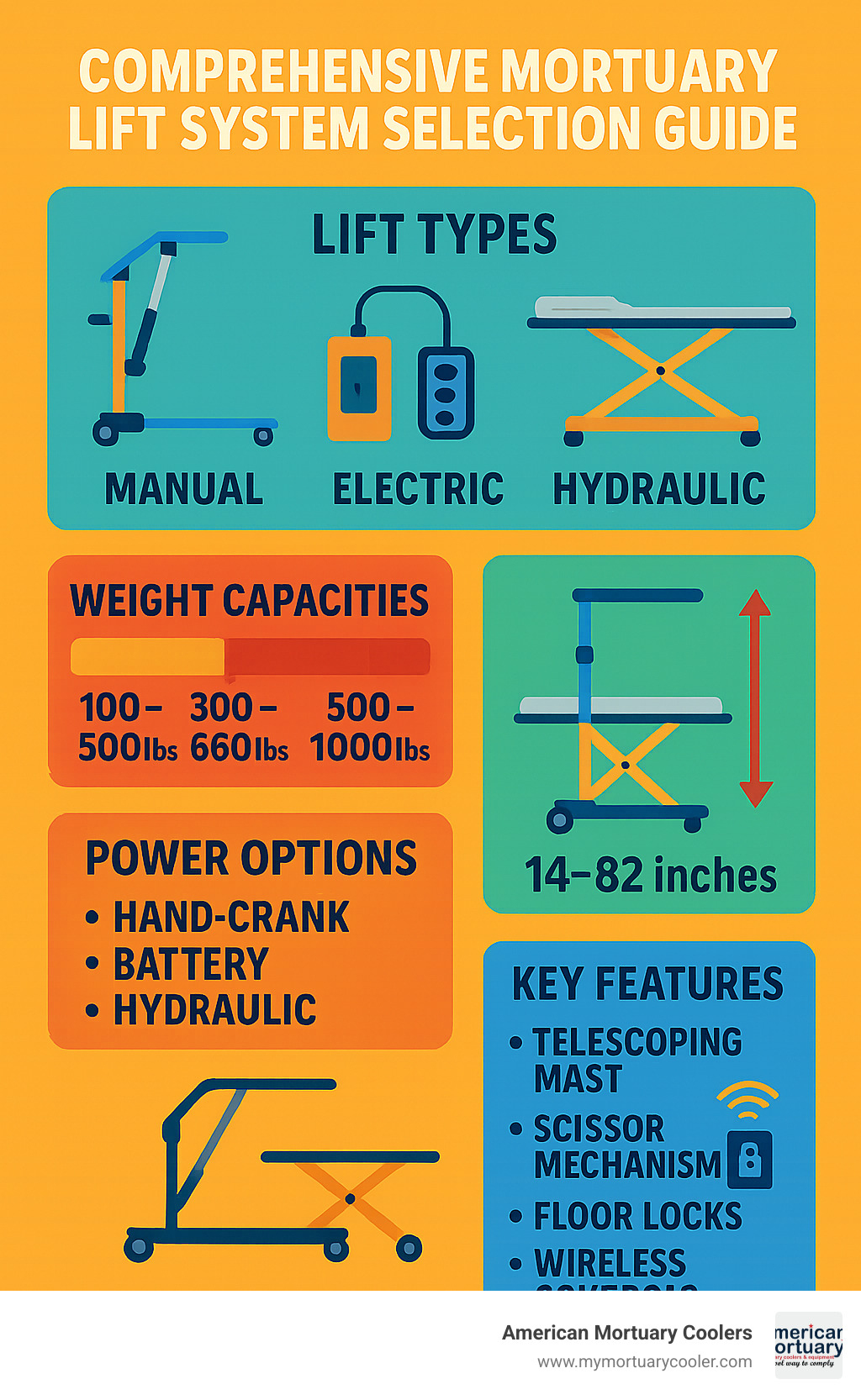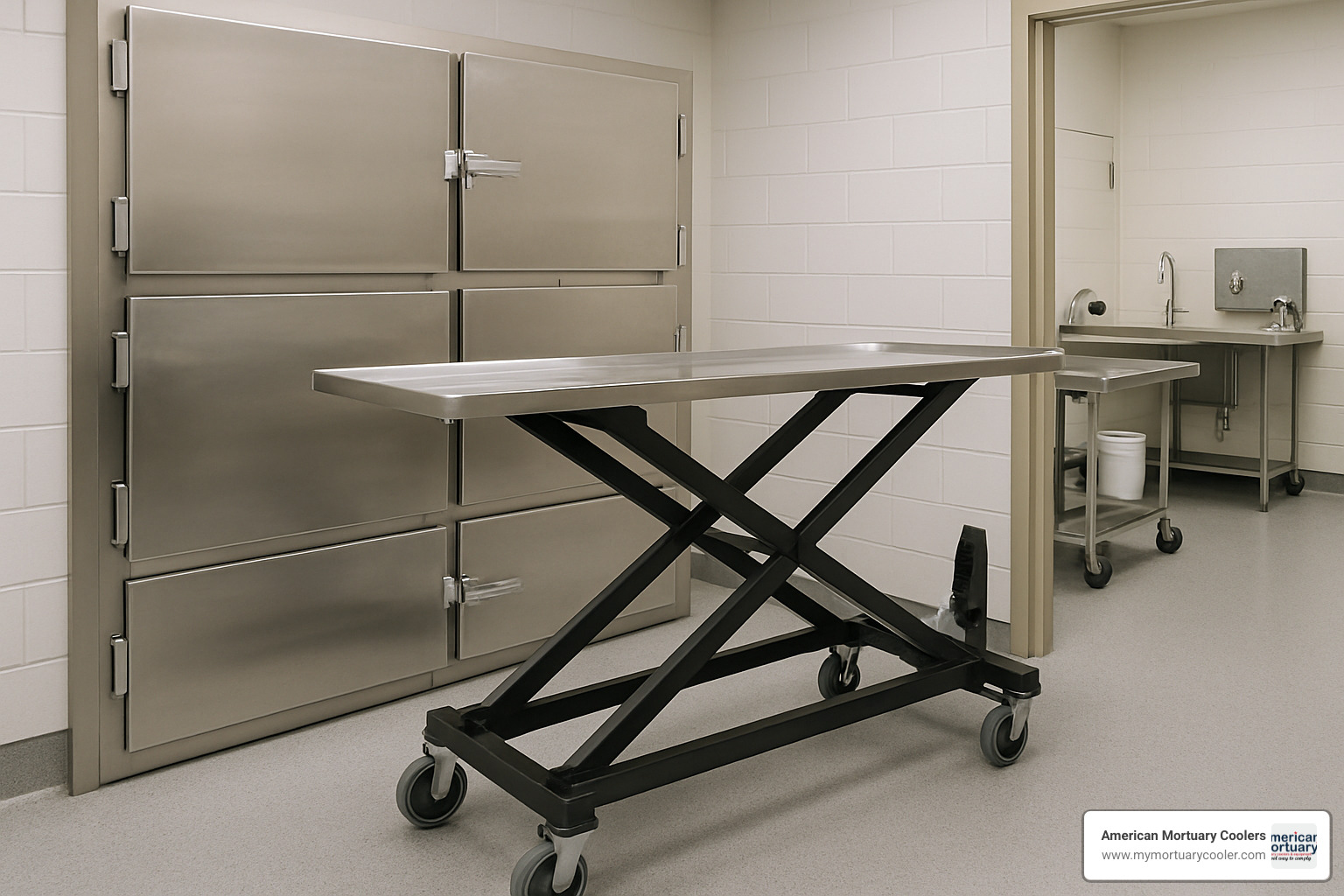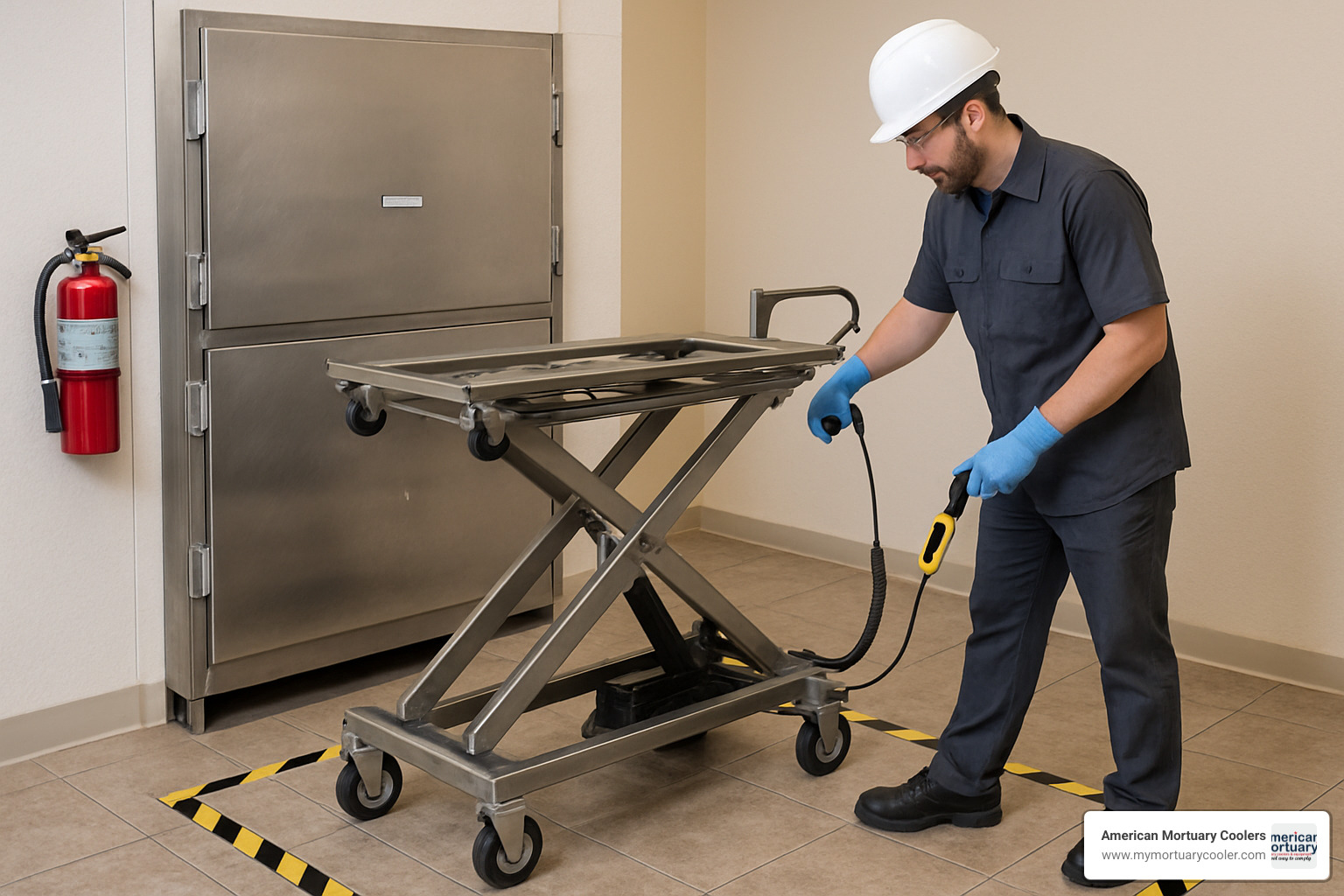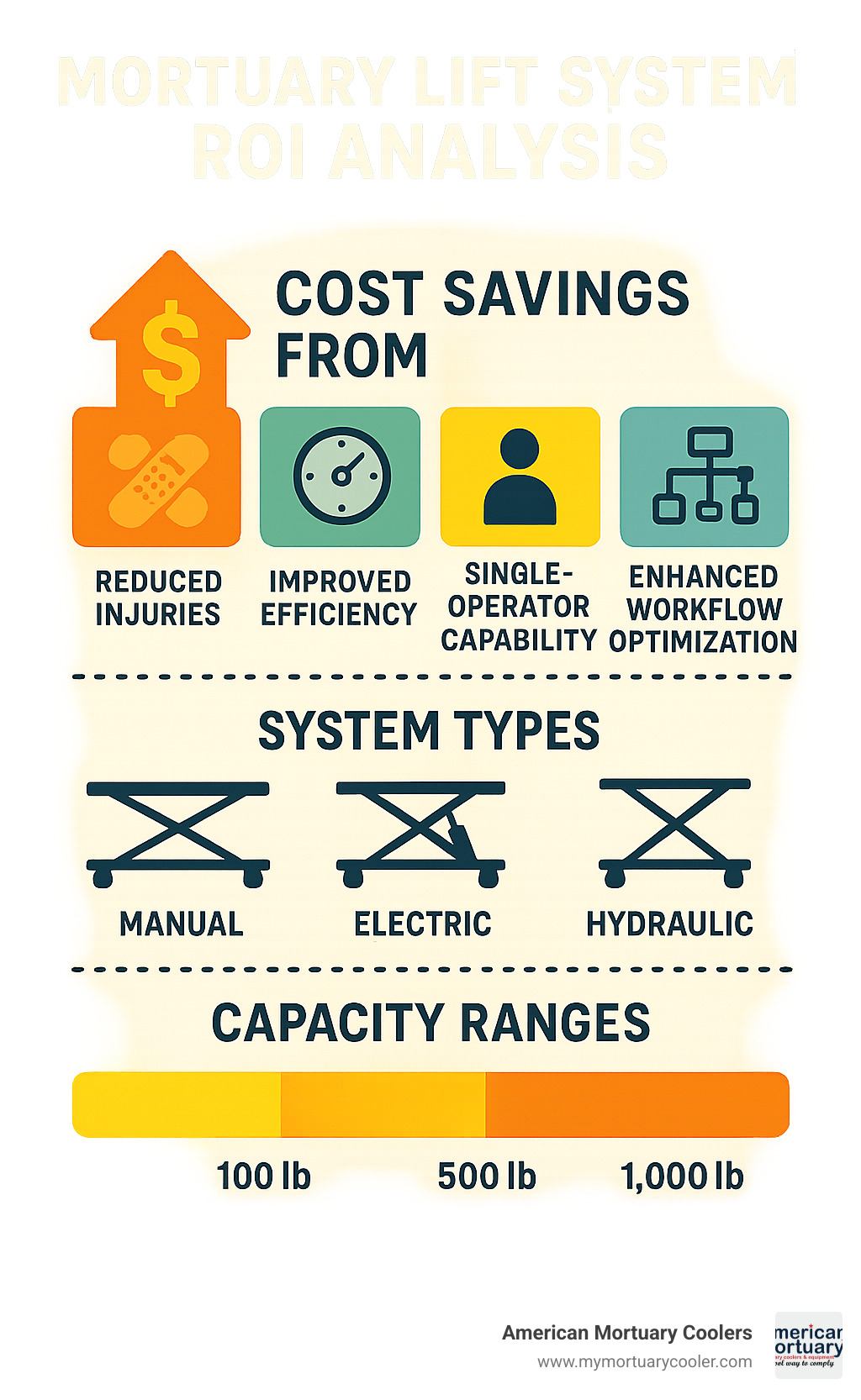Why Every Funeral Home Needs a Reliable Mortuary Lift System
A mortuary lift system is specialized equipment designed to safely raise, lower, and position bodies, caskets, and stretchers in funeral homes, morgues, and hospitals. These systems eliminate the physical strain of manual lifting while improving operational efficiency and workplace safety.
Key mortuary lift system types and capacities:
- Manual/Hand-crank lifts - 100-500 lbs capacity, telescoping mast design
- Electric/Battery lifts - 300-660 lbs capacity, pendant control operation
- Hydraulic/Scissor lifts - 500-1000 lbs capacity, 14-82 inch height range
- Bariatric specialty lifts - Up to 1000 lbs for oversized cases
- Stair climbing systems - 375 lbs capacity for multi-level facilities
The funeral industry has relied on these systems for decades. Over 10,000 Florlift mortuary lifts have been in use across funeral homes since 1954, while the Ultimate 1000 Lift has remained one of the best-selling casket lifts for over 50 years.
Modern mortuary lifts address critical operational challenges:
- Reduce staff injury from manual lifting of 200-1000 lb loads
- Enable single-operator handling of remains up to 660 lbs
- Provide precise height adjustment from 14 to 82.5 inches
- Improve workflow efficiency in prep rooms and loading areas
I'm Mortuary Cooler from American Mortuary Coolers, a national-level mortuary equipment supplier with extensive experience helping funeral homes select the right mortuary lift system for their specific needs.

Key mortuary lift system vocabulary:
Understanding Mortuary Lift Systems
A mortuary lift system is specialized equipment engineered to safely transport, position, and transfer human remains throughout professional mortuary environments. These mechanical devices eliminate the physical strain and safety risks of manual body handling that previously caused serious injuries among funeral service staff.
Modern systems handle loads from 100 to 1,000 pounds, allowing a single operator to safely move and position bodies up to 660 pounds. This capability transforms funeral home workflows and significantly improves both safety and efficiency.
At American Mortuary Coolers, we've seen how these systems integrate beautifully with our custom mortuary coolers. When proper lifting equipment works seamlessly with quality storage systems, the entire operation flows smoothly from body storage through final preparation.
For technical details, there's a helpful downloadable cadaver lift manual covering operational guidelines for hand-crank models.
Primary Functions of a Mortuary Lift
Every mortuary lift system performs three core functions: transfer, lift, and load/unload operations.
Transfer operations move remains between different surfaces - from transport stretchers to preparation tables, or from cooler compartments to autopsy surfaces. These transitions become smooth and safe, protecting both the deceased and staff.
Lifting functions provide precise vertical positioning with impressive ranges from 14 to 82.5 inches. This covers everything from floor-level loading to transferring into high-clearance vehicles, with optimal ergonomic positioning for preparation procedures.
Load and unload operations enable safe transfer to and from vehicles, cooler compartments, and storage areas. Before lift systems became standard, this heavy lifting led to countless workplace injuries in the funeral industry.
Safety & Efficiency Gains
The safety improvements from proper mortuary lift systems are remarkable. Manual lifting of bodies weighing 200 to 1,000 pounds creates serious risk for back injuries and musculoskeletal problems among funeral service staff.
With electric and battery-powered lifts, a single operator can safely handle bodies up to 660 pounds, eliminating the need for multiple staff members to perform dangerous manual lifting. Tasks that previously required 2-3 staff members can now be accomplished safely by one person.
The efficiency gains extend beyond injury prevention. When you don't need multiple people for routine transfers, staff can focus on higher-value activities like family consultation and ceremony preparation, creating more consistent workflows and fewer scheduling challenges.
Mortuary Lift Types, Components & Features
When shopping for a mortuary lift system, each type serves different needs. Manual systems are reliable workhorses that never need power, electric models provide effortless operation, hydraulic lifts offer smooth, powerful performance, while bariatric lifts and stair climbers handle specialized situations.

At American Mortuary Coolers, we help funeral homes choose lifting equipment that works seamlessly with their cooler systems. Every mortuary lift system shares common components: reinforced frames, adjustable forks, swivel casters, and floor locks.
| Feature | Manual/Hand-Crank | Electric/Battery |
|---|---|---|
| Power Source | Hand operation | Electric/Battery |
| Operator Effort | Moderate physical effort | Minimal effort |
| Lifting Speed | Variable by operator | Consistent, controlled |
| Capacity Range | 100-500 lbs | 300-660 lbs |
| Portability | High | High with battery |
| Maintenance | Minimal | Moderate |
| Cost Range | $300-$2,000 | $2,000-$8,000+ |
Manual & Hand-Crank Lifts
Manual lifts are dependable systems featuring telescoping masts paired with winch systems. The single-speed winch feeds cable evenly through an idler roller system, preventing cable flats that jam cheaper equipment.
Quality manual lifts offer telescoping masts for precise height control while maintaining stability under load. Many break down tool-free for storage. These systems handle 100 to 500 pounds with reversible fork designs accommodating different stretcher configurations.
Electric & Battery-Operated Lifts
Electric lifts transform lifting from physical work to precise control. Pendant control systems provide smooth starts and stops with variable speed control. Battery-operated models offer electric convenience without wall outlet dependency.
The double scissor mechanism provides stable lifting throughout the 14.5 to 82.5-inch range. Safety features include automatic stops, overload protection, and emergency lowering capabilities.
Hydraulic & Scissor Lifts
Hydraulic systems represent premium lifting equipment. The double scissor mechanism provides exceptional stability while distributing weight evenly. These excel in high-volume operations requiring consistent performance.
The scissor lift design offers superior stability compared to mast-style lifts, with wide bases and low centers of gravity reducing tipping risks while providing rock-solid platforms for transfers.
Specialty Bariatric & Stair Lifts
Bariatric cases require specialized equipment handling up to 1000 pounds. These feature reinforced frames, wider wheelbases, and improved stability systems designed for oversized cases.
The Stepper™ electric stair climbing system handles up to 375 pounds, enabling safe stair transport with a single attendant. Bariatric systems typically use dual-motor designs for redundancy and improved lifting power.
Key Components to Know
Frame construction forms the foundation - heavy-duty steel with aluminum housing provides optimal strength-to-weight balance. Strap systems and fork extensions accommodate various body sizes and stretcher configurations.
Floor locks and stability systems prevent unwanted movement during operation. Control systems range from simple hand cranks to sophisticated wireless remotes, with emergency stops and overload protection providing additional safety layers.
How to Choose the Best Mortuary Lift System
Choosing the right mortuary lift system becomes straightforward when you ask the right questions. At American Mortuary Coolers, we've helped funeral homes find their perfect lift solution by focusing on actual needs versus perceived requirements.
The key factors are capacity requirements, height range, maneuverability, facility footprint, and compatibility with existing equipment. Being honest about your specific needs versus future possibilities helps identify the optimal solution.
For detailed guidance on evaluating suppliers, check our guide on choosing a mortuary lift company.
Matching Capacity & Height to Your Use Case
Standard operations work well with 100-500 pound capacity systems, while bariatric operations need 500-1000 pound capacity. Higher capacity systems also provide longer service life and reduced maintenance even with lighter loads.
Height requirements depend on your specific setup. The standard 14-82 inch range covers most applications, but specialized vehicles or unique architectural challenges might require extended ranges.
Frequency of use affects capacity choice - high-volume operations benefit from higher-capacity systems even for standard cases because extra structural strength provides longer service life.
Maneuverability, Footprint & Facility Layout
Your building eliminates certain options before considering features. Narrow corridors and tight corners require excellent maneuverability with swivel caster systems. Low ceilings limit maximum lift height and storage options.
Door widths trip up many buyers. Standard doorways accommodate most portable lifts, but wide-base bariatric systems might require architectural modifications. Storage considerations affect daily operations - some lifts break down compactly while others work better as permanent installations.
Integration with Coolers, Vehicles & Trays
Gantry systems and track installations extend lifting capabilities throughout facilities. We design our custom body coolers with lift integration in mind at American Mortuary Coolers, ensuring proper height matching between cooler compartments and lift systems.
Vehicle compatibility presents unique challenges since every hearse and transport vehicle has different height requirements. Your lift system must accommodate these variations while maintaining safe working heights.
For information about coordinating lift systems with cooling equipment, check our guide on durable mortuary coolers.
Budgeting & Total Cost of Ownership
Initial costs range from $300 for basic manual units to $8,000+ for premium hydraulic installations. Consider total ownership costs including maintenance, operating expenses, and productivity gains that often justify higher investments within the first year.
Warranty coverage and service availability factor into long-term costs. Systems with better warranty terms and local service support often cost less over their lifetime than cheaper units with limited support.
How a Mortuary Lift System Handles Bariatric Cases
Bariatric cases may exceed 800-1000 pounds, requiring specialized equipment. Reinforced frame construction and wider wheelbase designs improve stability and reduce tipping risks. Dual-motor systems provide redundancy and improved lifting power, with proper operator training being critical for safe bariatric operations.
Installation, Compliance & Maintenance Essentials
Proper installation and maintenance of your mortuary lift system creates a safe, efficient workspace that serves families with dignity for years. The difference between seamless daily operations and ongoing headaches often comes down to these crucial details.

Installation complexity varies from portable units that roll into place to permanent track systems requiring structural modifications. Compliance requirements include OSHA workplace safety standards and local health department regulations. Steam cleaning capabilities are often required for proper sanitization.
For permanent installations, explore options at VIEW TRACK AND GANTRY for technical requirements and capabilities.
Installation Checklist
Door widths cause the most installation problems. Measure clearance for maneuvering loaded lifts through openings, not just the doorway itself. Ceiling clearance must account for maximum lift height plus operator working room.
Electrical requirements range from simple outlets for portable units to dedicated circuits for permanent installations. GFCI protection is required in potentially wet environments. Floor conditions matter - uneven surfaces create stability problems while certain treatments interfere with caster operation.
Maintenance & Service Schedule
Daily inspection takes less than two minutes but prevents most problems. Quick visual checks of straps, cables, and moving parts before use could prevent serious accidents.
Quarterly lubrication keeps everything moving smoothly and prevents premature wear. Strap replacement represents the most critical maintenance task - these components bear full weight and face constant chemical exposure. Worn straps can fail catastrophically without warning.
Battery maintenance involves proper charging cycles and storage procedures to extend battery life and ensure reliable operation when needed most.
Meeting Health, Safety & Hygiene Standards
Personal protective equipment should be standard for any body handling operation. Disinfection procedures must address routine cleaning and emergency contamination response, with steam cleaning enabling thorough sanitization meeting ADR standards.
Record keeping demonstrates regulatory compliance and provides valuable maintenance optimization data. Training programs ensure everyone understands proper operation and safety procedures, with regular refresher sessions keeping skills sharp.
Frequently Asked Questions about Mortuary Lift Systems
Funeral directors considering mortuary lift systems often have similar questions about capacity, maintenance, and operation. After helping hundreds of funeral homes select equipment, these are the most common concerns we address at American Mortuary Coolers.
How much weight can an average mortuary lift system handle?
Most mortuary lift systems handle 500 to 660 pounds for everyday operations, with specialized bariatric systems safely handling up to 1,000 pounds. Manual hand-crank systems work well for 100-500 pounds, while electric and hydraulic systems handle 300-1,000 pounds.
Remember you're not just lifting body weight - account for stretchers, caskets, and equipment that add to total load. I recommend considering your heaviest possible scenario rather than just average cases, as the bariatric market has grown significantly.
What maintenance does a mortuary lift require?
Manual systems require basic lubrication and occasional strap replacement. Electric systems need battery replacement every 2-3 years plus electrical component attention. Hydraulic systems require fluid changes, seal inspections, and pressure system checks.
For all systems, follow this routine: daily visual checks before use, weekly cleaning and sanitization, and monthly detailed inspections. The key maintenance item across all systems is strap replacement - don't compromise on quality replacement straps designed for mortuary use.
Can a single operator safely use a mortuary lift?
Absolutely. Electric and battery-powered systems allow one person to safely handle loads up to 660 pounds. Key safety features include floor locks, precise control systems, and emergency stops.
Single-operator capability transforms funeral home operations by eliminating coordination challenges and making staff scheduling more flexible. However, comprehensive training for all operators is essential to understand capabilities, limitations, and safety procedures.
Conclusion
Choosing the right mortuary lift system transforms daily funeral home operations. Whether investing in a $300 manual system or premium $8,000 hydraulic installation, the right choice becomes invisible infrastructure while the wrong one creates daily frustrations.
Start with honest needs assessment: capacity requirements from 100 to 1,000 pounds, height ranges spanning 14 to 82 inches, and power preferences between manual, electric, and hydraulic systems. Consider integration with existing coolers, facility constraints, and staff acceptance.
The investment pays for itself quickly through reduced workplace injuries and efficiency gains from single-operator capability. Quality lift systems become essential infrastructure supporting both operational excellence and staff wellbeing.
At American Mortuary Coolers, we've seen how proper equipment combinations transform operations. When mortuary lift systems work seamlessly with our custom cooling solutions, facilities operate more smoothly with bodies moving efficiently from storage to preparation areas while staff work safely and confidently.
Our coordinated equipment planning across diverse markets shows that integrated solutions make all the difference. Systems that work perfectly with your coolers, fit your facility layout, and match operational patterns become assets serving you for decades.
Direct delivery across the contiguous 48 states means we support your equipment decisions regardless of location. Whether upgrading existing equipment or planning new facilities, our team understands lift system integration with cooling equipment and facility workflows.
The funeral service profession deserves equipment supporting operational excellence and staff wellbeing. Quality mortuary lift systems represent exactly that investment - improving efficiency while protecting funeral service professionals dedicated to serving families in difficult moments.
For comprehensive information about mortuary lift solutions and integration with our cooling systems, explore our detailed offerings at mortuary lift solutions. Our team is ready to help you select equipment meeting your specific needs while providing the reliability and safety your facility demands.



















